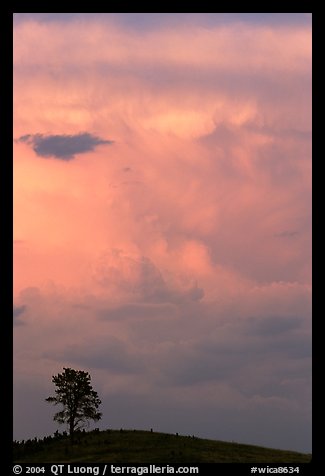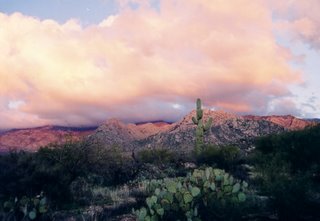Many liberals and progressives are pleased to see a resurgence of the religious left, a liberal, socially engaged form of Christianity led by figures such as
Jim Wallis, editor of
Sojourners Magazine. But can any faith based in the Abrahamic traditions be free of the authoritarian and violent elements found in the Christain right, the Islamic right, and the Jewish right in Israel?
Barry Seidman, writing for
Truthdig (
A Critique of the New Religious Left), says the answer is no, and he bases his argument on the book by Hector Avalos, “
Fighting Words: The Origin of Religious Violence” (2005). Avalos argues that the history of religious violence is rooted in a perceived lack of resources (this could easily be seen as the root of
all violence, not just religious), and that Christianity has this perceived lack just as much as the old Hebrew faith and the hardline Islamic faith.
Avalos’ main argument is that violence stems from real or perceived scarcities of resources. When we look at the Bush administration’s invasion of Iraq, we see the very real concern with the dwindling oil reserves on Earth, and how the oil-made members of the administration would risk personal economic disaster if Iraqi oil were to actually serve the Iraqi people. But in addition to real resources, “perceived resources” can also become the focus of violence—and all too often these resources have been created by our religious books.
According to Avalos, one of these perceived resources stems from what he calls “group privileging.” For example, the Jewish belief that Israel is the chosen land—and that Jews are a chosen people—necessarily elevates Jews in their own eyes above all other people on Earth. This perceived scarcity—the scarcity of being God’s “favorite”—can be seen in Israel’s current policy toward the Palestinians.
___
Many Christians, I have found, will not argue against the notion of the angry, retributive God of the Hebrews. In fact, they often point out this truth in order to distinguish themselves from the Jews. This is where Wallis and other liberal religionists begin their arguments for the so-called Prince of Peace.
But Avalos finds plenty of perceived scarcities directly in the New Testament. One such scarcity is the idea of “sacred space.” In John 2:14-17 we find an account where Jesus whips people in a temple for selling animals and then goes on to wreck the place. Christian apologists have argued that this violence was justified because of blasphemy committed in a house of God. Avalos argues then that “since Jesus is a paradigm of Christian conduct, his actions came to influence some of the violence linked to sacred places we see in later Christian history.” (8) Avalos here is referring to the Crusades, among other historical Christian atrocities.
But Jesus did much more than this to ensure the cult-like following he would soon receive. Proclaiming himself the voice of God, he prepared the needy and fearful for future battles they were to endure while spreading Christianity. One such method is most probably the same sort used by Islamic fundamentalists when recruiting suicide terrorists. In Luke 14:26-27, Jesus says, “Whoever comes to me and does not hate father and mother, wife and children, brother and sister, yes, and even life itself, cannot be my disciple.” Mighty strong words no doubt meant to dedicate his followers to developing an artificial kinship with non-family members who would then fight as blood kin to the death for their perceived resource—God him/her/itself.
Even apart from his discussion of religious-created scarcities, Avalos uses a close reading of the Bible to reject the view that Christianity essentially espouses love and peace. He argues that in Romans 12:14 we do not really see an example of Christians loving their enemies at all, though this section is often cited by Christians for this very reason. The section begins, sure enough, “Bless those who persecute you; bless and do not curse them.” But what most liberal Christians then ignore is the rest of the section, “If your enemies are hungry, feed them; if they are thirsty, give them something to drink; for by doing this you will heap burning coals on their heads” (Romans 12:20). Heaping burning coals on their heads? Avalos suggests that read as a whole, the commandment to be nice is a way to build up the potential for violence against an enemy. The nicer one is to one’s enemies, the more they will deserve the violence done to them in the end.
I've included quite a bit of Seidman's restatement of Avalos' argument so as to demonstrate how elevated teachings can be terribly misunderstood by those who see the world through more limited viewpoints.
This last section is the easiest to dismantle. The heaping of burning coals is not meant as a literal image, as Avalos argues. Jesus is making a point about the suffering of guilt and wrongdoing. If you love thy enemy you are purifying your own heart, but the enemy will feel ashamed and guilty for his actions, which to Jesus is equivalent to burning in hell. There is no intent to inflict physical pain in Jesus' words.
Further up, Avalos talks about Jesus telling his followers they must hate their families to truly be his desciples. He is not preparing them to sacrifice their lives for the cause (and here Avalos sounds like one of the Islamic Imans he seems to oppose), but rather is advocating nonattachment as the only way to approach the nonduality with God the Father that Jesus himself experienced.
Based on what little is cited here by Seidman, I have to think that Avalos' book is deeply flawed in that he is incapable of anything other than a literalist reading of the Bible. Even Jesus' followers 2,000 years ago were capable of undertsanding allegory.
Truthdig promotes Seidman as being in the tradtion of Sam Harris, and I guess by that they mean that he is a scientific humanist. However, he seems, like Harris, to also be a flatlander -- someone who views the world only through the exterior reality lens, specifically the exterior individual (science). Both men reject much of the interior individual (self and consciousness) as nothing more than subjective experience that cannot be validated, and they reject the interior collective (culture and worldview) as dangerous and superstitious. Both men also reject any form of developmental progression of worldviews, and therefore feel safe in a wholesale rejection of religion as dangerous and unnecessary.
We should be supporting liberal Christians. Theirs is a much healthier version of the religion than is found on the religious right. When Christianity moves beyond authoritarianism and becomes more liberal and progressive, it sheds much of its violent baggage. This is the healthier version of Christianity that I have repeatedly suggested is an antidote to Sam Harris' view that all of Christianity is dangerous.
Scientific humanism is as dangerous to humanity as fundamentalism, and is, in fact,
a kind of fundamentalism. It is as extreme in its hatred of religion as the religious fundamentalists are in their hatred of the scientific and the secular.
If we were to do away with religion as the scientific humanists propose, the results would be far more catastropic than anything a bunch of religious fundamentalists could ever accomplish. Let me try to explain.
When liberals decided that religion was an oppressive institution back in the sixties, they worked to remove faith-based community centers and to reduce the influence of churches in our inner cities. The result was the breakdown of authoritarian structure and the unleashing of ego-driven power drives (the rise of urban gangs). Don Beck has documented this in a few articles (based on Graves' work as far as I know) and talks about it during
SDi trainings.
Now imagine the same loss of religious control and structure on a global scale. Imagine the African continent without Islam or Catholicism. Imagine the Middle East and India/Pakistan without solid religious structures to maintain some semblance of order.
Now Seidman and Harris might argue that the same control could be maintained with a secular system. Maybe, but the only variations we've ever seen on a wide scale were fascism and communism. They weren't so pretty.
The truth is that we need religion. Rather than doing away with it, we should be trying to find ways to help it express itself in a more balanced and healthy way. The progressive version of Christianity promoted by Jim Wallis and others like him is the healthiest solution I have seen so far. We should be grateful for its presence and help it become even healthier and more widespread.
Technorati Tags: Barry Seidman, Hector Avalos, Sam Harris, Progressive Christianity, Jim Wallis, Abrahamic Faiths, Fundamentalism, Scarcity of resources, Truthdig, Scientific Humanism




















